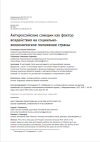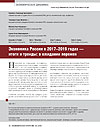“Unpredictable” Results of 2022 and Potential Threats to Russia’s Strategic Development in the Current Year
DOI: 10.33917/es-2.188.2023.44-49
The article addresses the change in the market index of “Economic Strategies” (MIES) for 2022. Contribution of the supply and demand indicators to the KIES is assessed. Dynamics of industrial production is analyzed.
References:
1. Poslanie Prezidenta Rossiiskoi Federatsii Federal’nomu sobraniyu Rossiiskoi Federatsii ot 21 fevralya 2023 g. [Address of the President of the Russian Federation to the Federal Assembly of the Russian Federation of February 21, 2023]. Ofitsial’nyi sait Prezidenta RF, available at: http://kremlin.ru/events/president/news/70565.
2. Otsenka chislennosti postoyannogo naseleniya na 1 yanvarya 2023 g. i v srednem za 2022 g. i komponenty ee izmeneniya (s uchetom itogov Vserossiiskoi perepisi naseleniya 2020 g.) [Estimated Resident Population as of January 1, 2023 and on Average for 2022 and Components of its Change (Against Results of the 2020 All-Russian Population Census)]. Federal’naya sluzhba gosudarstvennoi statistiki, available at: https://rosstat.gov.ru/folder/12781.
3. Sotsial’no-ekonomicheskoe polozhenie Rossii v yanvare — dekabre 2022 goda: Doklad [Socio-Economic Situation in Russia in January-December 2022: Report]. Federal’naya sluzhba gosudarstvennoi statistiki, available at: https://rosstat.gov.ru/storage/mediabank/osn-12-2022.pdf.
4. Sotsial’no-ekonomicheskoe polozhenie Rossii v yanvare 2023 goda: Doklad [Socio-Economic Situation in Russia in January 2023: Report]. Federal’naya sluzhba gosudarstvennoi statistiki, available at: https://rosstat.gov.ru/storage/mediabank/osn-01-2023.pdf.
5. Frenkel’ A.A., Tikhomirov B.I., Surkov A.A. Itogi razvitiya mobilizatsionnoi ekonomiki Rossii v yanvare — sentyabre 2022 g.: bor’ba za gosudarstvennyi suverenitet [Results of the Development of the Mobilization Economy of Russia in January — September 2022: the Struggle for State Sovereignty].
Ekonomicheskie strategii, 2022, no 6(186), pp. 30–35, DOI: 10.33917/es-6.186.2022.30-35.
6. Informatsiya ob uchastii Prezidenta RF v rabote ezhegodnogo s”ezda Rossiiskogo soyuza promyshlennikov i predprinimatelei (RSPP) 16 marta 2023 g. [Information on Participation of the President of the Russian Federation in the Annual Congress of the Russian Union of Industrialists and Entrepreneurs (RSPP) on March 16, 2023]. Ofitsial’nyi sait Prezidenta RF, available at: http://kremlin.ru/events/president/news/70688.





















